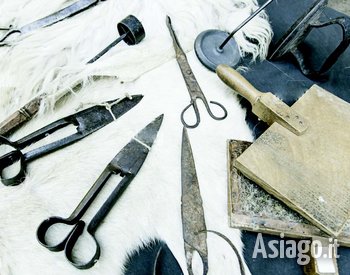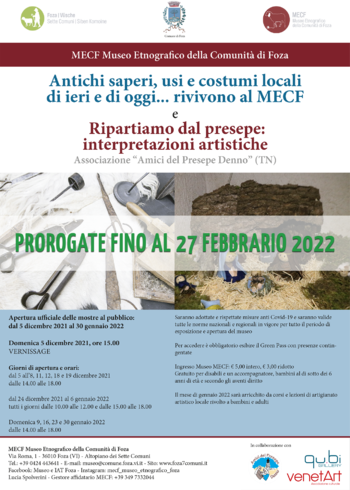
From 5 December 2021 to 27 February 2022 the MECF – Ethnographic Museum of the Community of Foza – will host an exhibition project linked to the knowledge and dissemination ofthe art of local craftsmanship and not entitled "Ancient knowledge, customs and local customs of yesterday and today ... relive at the Mecf".
On display a rich variety of artistic handicrafts, the result of ancient traditions that bring back to distant knowledge of communities linked to their roots.
The month of January 2022 will be enriched by courses and lessons of local artistic crafts aimed at children and adults.
The exhibition will be inaugurated on Sunday 5 December at 15:00.
In the same period at the Mecf it is also possible to visit the exhibition with an exhibition of artisan representations of the nativity of Christ, in collaboration with the"Friends of the crib of Denno".

Opening days and opening hours
- from 5 to 8, 11, 12, 18 and 19 December 2021 from 14.00 to 18.00
- from 24 December 2021 to 6 January 2022 every day from 10.00 to 12.00 and from 15.00 to 18.00
- Sunday 9, 16, 23 and 30 January 2022 from 14.00 to 18.00
- Sunday 6, 13, 20 and 27 February 2022 from 15.00 to 19.00
Extraordinary midweek openings by reservation.
Entrance
€ 5,00 full ticket
€ 3,00 reduced ticket
Free admission for disabled people with a companion, children under 6 years of age and those entitled.
Access allowed only with GREEN PASS STRENGTHENED (and use of the FFP2 mask)
THE EXHIBITION
The history of popular traditions is a field of knowledge, an anthropological discipline. Tradition comes from the past, but it is we, men of the present, who give it meaning. We take from the past what interests us and create a tradition. This is the message that wants to promote the Ethnographic Museum of the Community of Foza, presenting to the public a rich variety of artistic handicrafts.
Have you ever wondered what is the history of wool? Wool is a very popular material that has always been part of the textile industry. In this exhibition you will briefly know its history, how it is obtained and how it is worked. According to some studies, wool has been used since 3000 BC.C., in Mesopotamia, but its production on an industrial scale dates back to the seventeenth century BC.C. Wool is obtained from the fleece of some sheep such as sheep and goats but partly also from other animals, such as camelids, yak and Tibetan antelope. The wool fiber is obtained by the yarn of the raw material from these animals, it is therefore a natural textile fiber. Even in Ancient Greece the importance of wool was predominant, since the Iron Age the most widespread textile material. In Roman times we owe the introduction of shears to remove wool from animals, without the barbaric ancient techniques of tearing it directly from the body of the animal, while it is with the Middle Ages that wool sees its most flourishing period of diffusion.
The origins of crochet are lost a bit in the mists of time... they are difficult to reconstruct with certainty, also because the ancient specimens that have come down to us are few. It is thought that the first works of this type were done with the fingers, which were used to create the loops and resume the stitches; over time a tool similar to modern crochet would develop, made first of wood, bone or bamboo and later of ivory and amber. It seems that this technique was already part of Egyptian culture and "primitive" examples have been found in every corner of the world.
The beginning of knitting does not have a certain date due to the difficulty of distinguishing whether the information received concerned the work performed on the knitting or the loom work. What is certain is that this topic, recently re-evaluated by in-depth studies, offers us reliable and documented news only when we stop at the second or third century after Christ because before history is too often confused with legend. However, sculptures dating back to the fourth century BC have been found.C, which have led to the hypothesis that knitting had now entered everyday life, as evidenced by a Greek statue, which is located in Athens, in the Parthenon Museum, Kore n. 670, which seems to wear a sweater like that of our times. Only in the Christian era is it possible to examine the first find of knitting, analyzing its structure and colors.
The history of bead processing is rooted in the distant past. But there are always masters who prefer this type of embroidery, decorate their daily life and present their works at exhibitions. The appearance of the pearls themselves and embroidery with beads became possible only with the advent of glass processing. Glass production was born in Phoenicia 6 thousand years ago. According to legend, Phoenician sailors carried soda from Africa, landed for the night and surrounded the fire with pieces of soda, and the next morning they found transparent and hard stones in the ash - glass. They began to make pearls of it. Then gradually small pearls appeared. The Republic of Venice has become the center of bead production in Europe. The secrets of glass processing were carefully guarded. At the end of the XVII century in Northern Bohemia, Bohemian craftsmen created a technology for the production of "forest glass", in which wood ash was used instead of soda. Bohemian glass looked good and was easy to cut. Over time, Czech pearls have replaced Venetian pearls on the world market. The Czech Republic to this day is one of the leaders in the production of beads. In ancient Russia, pearls were used already in the IX-XII century. Initially, pearls were used for sewing. It was quite accessible because in the lakes and rivers there were many freshwater pearl mussels. The clothes were decorated with small pearls. From the eighteenth century, national costumes were also decorated with beads.
It is said that felt is the first fabric produced by man, second only to the interweaving of vegetable fibers, a process probably much older than that of wool. The oldest traces of wool felt date back to the third millennium a.C. and are located in Siberia. In addition, there are important traces of prehistoric felts in Turkey. It was also used by the Greeks and Romans for the manufacture of clothes, headdresses and cloaks. The invention of felt, in legend, is attributed to St. James the Apostle. The saint, who was a fisherman, could not bear the consequences of the long walking distances required by the preaching work. To protect the soles of his feet he tried to stuff the sandals with woolen balls that the sheep, in grazing, left attached to the thorny bushes. He noticed that the layer of wool pressed by its weight and wet with sweat hardened and turned into a compact, soft and comfortable aquifer. Hence the invention of felt.
Anti-Covid-19 measures will be adopted and respected and all national and regional regulations in force for the entire period of exhibition and opening of the museum will be valid.
To access it is mandatory to show the Green Pass with contingent attendance.
For more information or to book contact the Museum / IAT of Foza by clicking on the green buttons below: